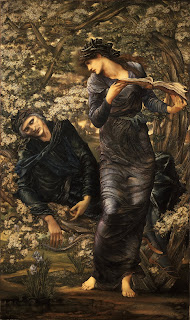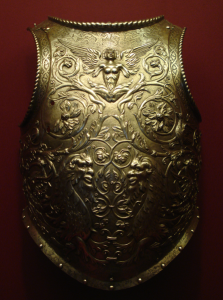 |
| Image from Wikipedia |
Here are a collection of special wards that may be added to wizard robes. I’m not totally sure about the power levels and costs of some of these, but I don’t think anything is too crazy.
Any ward may be decoded with read magic (though see obscuring ward below) and destroyed with dispel magic (the wearer’s saving throw versus magic applies).
- Elemental ward.
Choose one: fire, cold, lightning. You may re-roll the next failed saving throw of the given type. Doing so exhausts the ward. Minor effects related to the element in question often manifest around the wearer, though generally in subtle ways (a faint aura of cold, sparks when walking on stone, etc). Cost: 500 GP. Components: the remains of an elemental creature of at least 3 HD. - Paralytic curse.
Anyone other than the attuned magic-user donning the robe must make a save versus paralysis or be frozen in place indefinitely. If the save is successful, paralysis is avoided, but the wearer feels uncomfortable and nauseous (taking a -2 to all rolls). Cost: 500 GP. Components: the spleen of a ghoul. - Obscuring ward.
This ward disguises the nature of another ward. It either hides a ward completely or makes it appears as a different (non-functional) ward. Useful for disguising wards that may rely on forbidden magic, such as diabolism or necromancy. Cost: 500 GP. Components: blood of an adulterer. - Flaming retribution.
If the wearer is slain, a fireball detonates with ground zero at the wearer. Cost: 100 GP per die of fireball damage, max = robe level. Components: ash from a home that was burned to the ground. - Protection from evil.
Choose one: demons, undead, faeries. As per the spell. Any hostile action (referee determination; the player should be given information about what constitutes hostility) grants the creature a saving throw versus magic to destroy the ward. Creatures of this type can also sense the ward and thus have a -2 on any reaction roll. Cost: 1000 GP. Components: captured creature of the appropriate type (minimum 3 HD), sacrificed or ritually destroyed. - Demonic sympathy.
The true name of a demon is inscribed as a ward. If the attuned wearer dies, the demon is destroyed. If the ward is dispelled, the demon is freed. Cost: 1000 GP. Components: demon’s true name. - Undead retribution.
If the wearer is slain, she raises as a wraith and inexorably pursues the killer. Cost: 1000 GP. Components: fat rendered from the flesh of a person killed by terror or energy drain. - Precipitative ward.
Rain, snow, and other natural precipitation falls around rather than on the magic-user. Winds are calmed slightly, but not entirely (gale-force winds remain dangerous). Cost: 50 GP. Components: cloud, bottled and preserved. - Relay ward.
This ward must be created voluntarily with another magic-user. The other magic-user may cast spells through the wearer, though targeting is still up to the wearer. This also creates some form of unidirectional magical channel between the two, and the remote magic-user will always be able to sense the approximate direction and distance of the wearer (the remote magic-user also gains a +2 to all saves versus spells cast by the wearer). Some masters use this ward in order to control their apprentices. Cost: 1000 GP. Components: blood from both parties, freely shed, mingled. - Sartorial ward.
Robes may shift in appearance as long as they continue to maintain approximately the same surface area. All wards remain visible unless magically obscured. Robes must continue to appear as some form of clothing. Cost: 100 GP. Components: the ashes from a suit of currently fashionable clothing, burned. - Necropotent ward.
No life will come into being within 10 feet of the robes. Living plants will also gradually die, and animals will become uncomfortable (-2 reaction roll). Useful as a magical form of contraception. Cost: 100 GP. Components: crops spoiled prior to harvest. - Seelie friendship.
Must be created jointly with another magic-user of the Seelie court. +2 reaction rolls with members of the Seelie, -2 reaction rolls with members of the Unseelie. Generally awarded as a boon to magic-users that have helped the Seelie court. The reverse, Unseelie friendship, is also possible, but obviously not both at the same time. Cost: 500 GP. Components: blood shed in violence of a member of the opposing court.





